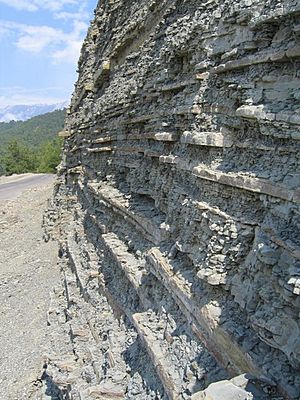Bed (geology) facts for kids
In geology, a bed is like a single layer in a giant stack of rocks. It's the smallest division of rock or sediment you can find. Think of it as a distinct sheet of rock. These layers are separated by clear flat surfaces called bedding planes. These planes show where one layer ends and the next begins.
A bed is the smallest lithostratigraphic unit. This means it's the tiniest piece of rock that geologists can identify based on its type. Beds can be very thin, just a centimetre thick, or quite thick, up to several metres. You can tell one bed from another by looking at the type of rock, the minerals in it, or the size of the particles that make it up. We usually use the term "bed" for sedimentary layers, but it can also describe layers from volcanic flows or ash.
When people work in a quarry, which is a place where rocks are dug out, they also use the word bedding. Here, it means a natural way that rocks like granite can split. They often break along flat surfaces that are horizontal or parallel to the ground.
Engineering with Rock Beds
In geotechnical engineering, which is about how rocks and soil behave, a bedding plane is very important. It often creates a weak spot or a break in the rock. This can greatly affect how strong the rock is and how it moves. This is super important when engineers are building things like tunnels, foundations for buildings, or slopes. They need to understand these bedding planes to make sure their structures are safe and strong.
Related pages
Images for kids
-
Originally horizontal beds of sedimentary rock were tilted by the Alpine orogeny, at Angles, Alpes-de-Haute-Provence, France
See also
 In Spanish: Capa (geología) para niños
In Spanish: Capa (geología) para niños




